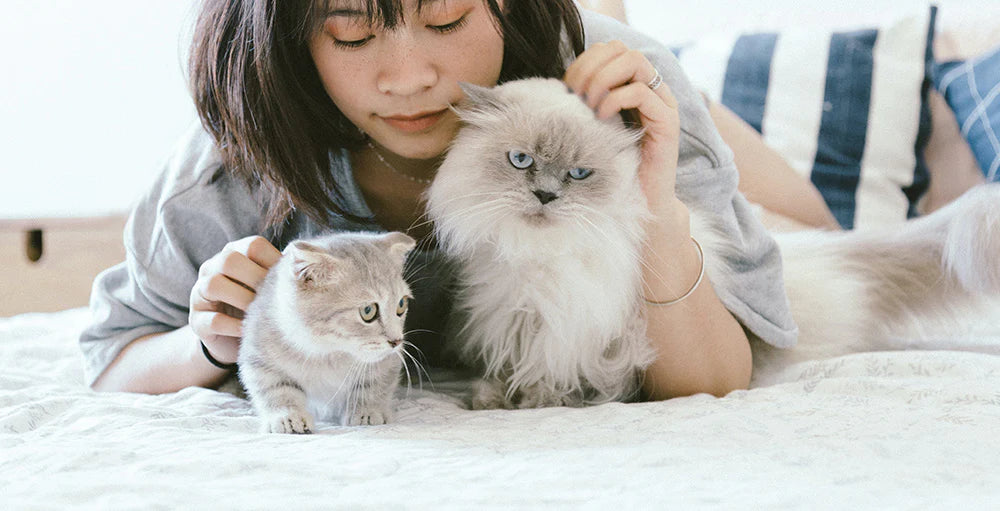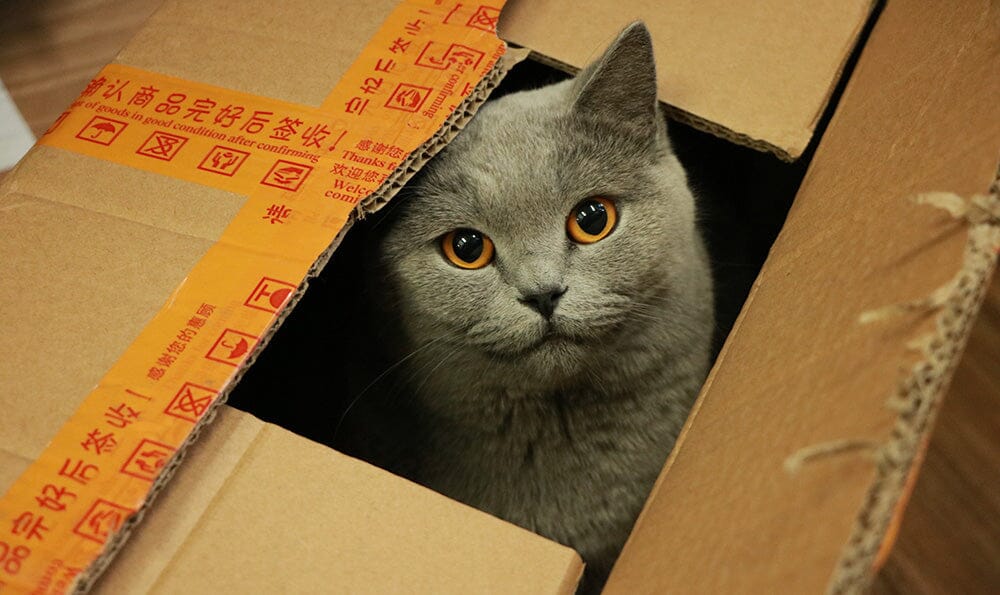How to Keep Your Cat Healthy, No Matter Their Age
Whether caring for a cuddly new kitten, a mature cat or a finicky senior, cats of all ages hold a special place in our lives. And although cats may have different needs as they age, the goal of any caring pet parent is to ensure that their kitty stays happy and healthy as long as possible, regardless of their age.
Fortunately, there are some health habits that are common and beneficial to cats of any age. Following these simple tips and incorporating these health habits into your routine as early as possible will help keep your feline furball living a calm, relaxed, and happy life.
If you are already doing some of these things, that’s great.
If not, adding the 7 tips and suggestions described below to your routine is fairly easy and will play a big role in keeping your cat healthier and happier for the long term.
By practicing these caring habits consistently (and that is key) you can make sure they are living their best life with you. And isn’t that worth it?
7 Steps to A Healthy Cat
Now some people may be thinking that cats are known to be very independent and don't require as much maintenance as dogs and other pets. While that may be partially true, like all pets, cats have some basic needs that must be provided for such as food, water, a comfortable place to sleep, activities to keep both their mind and body stimulated and of course lots of love.
That is why the following seven steps are critical to keep your cat healthy and making sure your kitty cat lives not just a long and happy life, but a healthy one.
1. Groom Your Cat Daily
Whether your cat has short or long fur, regular grooming is a must. And although most cats are fairly proficient at grooming themselves, this is a task you should not leave just to your kitty. Since cats lose hair quite often, it is important to brush them regularly. Not only does grooming a cat remove loose dead hair and skin that they may otherwise ingest while self-grooming, but it also helps to spread their natural skin oil throughout the coat . Grooming your cat will also help to prevent the formation of hairballs that can lodge in their digestive tract.
Even if you take your cat to a groomer regularly, we recommend that you also regularly stroke and brush your cat’s fur as it will help you to notice any bumps, sores, bald spots or lumps on their body. Discovering any changes to your cat’s fur early on can help to prevent any possible issues from becoming major health problems.
In addition to helping to detect problems, grooming your cat can be a great bonding activity that will not only help to soothe your kitty when they are feeling stressed, but it is also very relaxing and soothing for you as well.
Make grooming your cat a regular habit. Starting from the time they are kittens, or once you adopt them is a great way to get them used to being touched and cared for.
Consistent grooming will help your cat get used to being groomed by you and they will start looking forward to it.

If your kitty tries to escape during grooming, you can encourage them to cooperate by connecting the grooming with treats or a happy event. For example, if you brush them before a meal, your cat will likely associate the activity with something delicious and will look forward to it.
Two things to watch for with regards to grooming are:
1) if your cat runs away or avoids being groomed, and
2) if your cat overgrooms themselves
A cat that suddenly avoids being groomed may be trying to hide a problem with their skin that needs to be investigated. Carefully check the skin for mites, fleas, other parasites, or any wounds on the skin to see what may be causing the problem.
Another possibility for a cat running away, which can also happen if the cat is overgrooming, is that something has changed in their environment to cause them stress so they are running away or overgrooming as a way to hide and calm themselves. In this case, approach them gently and try to soothe them until you determine what may be causing this behavior.
Whether the issue is physical or emotional, paying attention to any changes to your cat’s coat as well as their reaction to being touched or groomed can be a great early indication of any possible issues.
2. Protect your cat's teeth
Starting at 10 weeks to about 6 months of age, cats’ teeth start to grow. By the time they are about 6 or 7 months, all of a cat’s 30 adult teeth are going to have most likely come out. Unfortunately, many cats don’t get to keep all their teeth into their senior years due to periodontal disease and tooth resorption. Feline oral diseases, plaque buildup, gingivitis and other mouth problems can lead to partial or even full removal of the cat’s teeth, causing some cats to stop eating altogether.
You can keep your cat healthy by taking care of their teeth.
Another issue affecting a cat’s oral health is stomatitis, an inflammation of the mouth and gums that leads to painful mouth sores and ulcers which make it difficult for a cat to eat and drink. Dental disease is such a common feline problem, affecting approximately 65% of cats over the age of 3 years, which is why dental hygiene is extremely important for keeping your cat healthy.
One way to prevent these issues is brushing your cat’s teeth regularly. This can be done by a vet, but can also be done at home. When first introducing a toothbrush and toothpaste to your cat, start slowly by first getting your cat used to having your fingers near its mouth. Gently touch them around the mouth and lips and slowly move to touching and checking their gums and teeth, before putting a toothbrush in their mouth. This may take a few days to a few weeks, but just be patient.
If your kitty won’t let you brush their teeth you can try some seafood-flavored cat toothpaste. Allow your cat to taste the toothpaste and play with the toothbrush before using it. Your cat might resist a few times but try to be persistent without being forceful.
If your kitty doesn’t like brushing no matter how hard you try, you can always add an oral rinse to their water, give them a natural oral care remedy for cats or give them dental treats periodically to protect their teeth.
3. Provide Mental Stimulation
While most cats spend their days lazily lying around for 11-16 hours, when they are awake it is important to keep their mind active and engaged. When a cat is young they generally tend to be more active as their curiosity leads them to explore their surroundings. Providing them with cat trees to climb, toys to chase and play with provides kittens with constructive ways to explore and learn about their surroundings.
Kittens that are not given enough stimulation and activity can become bored. Bored kittens tend to exhibit destructive behavior. A bored cat may also become an anxious cat. Playtime is not just a great way to get young kittens busy, but it is also a fantastic way for you to bond with your new kitten.
Play is not only good for kittens; just as for older people, playing and keeping the mind active is equally important for senior cats. While kittens can get into mischief if they are not occupied, senior cats also need to be stimulated and their minds occupied to keep them engaged and happy. Senior cats that are not provided with enough mental stimulation may start to decline and even become disoriented or appear confused or lost. This is one of the first signs of cognitive decline, occurring in about 40% of cats age 17 years and older.
Although cats have been stereotyped as low-maintenance pets, low activity or no engagement can lead them to get bored, decline mentally and experience greater anxiety. With a little creativity keeping your cat active and stimulated is not difficult. To satisfy their hunting instincts and give them interactive playtime, play with them, take them out for walks or give them toys that keep them engaged and active.
Some cats like playing fetch and will run up and down the stairs to catch a toy. If your cat is intelligent and curious you can try occupying them with cat-safe laser toys. Laser toys and feather poles are great for getting a cat’s mind busy. Plus it has the added benefit that running after and chasing a toy can keep them active and prevent obesity.
Dedicating playtime for your cats can ensure they remain mentally engaged and stimulated. It can also allow you to unwind and spend quality time with them.

4. Visit the Vet Regularly
If you have adopted a new cat, be sure to take them to the vet for a check-up to make sure they are healthy and do not have worms or other illnesses that can be passed on; especially if you have other pets in the house. (If you are not sure how, check out this blog for easy ways to check your new kitten for worms at home.)
It is important to look for a vet that specializes in feline health and anatomy and can provide your kitty with the best care possible. If your vet also has other canine clients, if possible, ensure to wait in a separate waiting room reserved for cats to prevent your cat from getting antsy or nervous in front of dogs.
Going to the vet regularly is important for your cat’s health as they can detect any issues early on before they become bigger health concerns. Finding the right vet is important; whether holistic or traditional, they should be able to answer any questions you have, not be pushy, and their style should match what you are comfortable with.
A good vet can be an excellent resource for any issues you might face, whether big or small and you should be able to trust them regarding your pet’s well-being. Ultimately, remember that you are advocating for your fur baby, so make sure that you get all your questions answered to your satisfaction to keep your cat healthy.
5. Be Attentive to Nutrition
The first step to keeping your cat healthy is properly addressing their nutrition needs. Start off by choosing high-quality cat food for your cat, and keep the treats to a minimum. Keep in mind that kittens, adult kitties, and senior cats have different nutritional needs. It is also important to regulate how much food your cat gets based on their age and activity level to make sure they do not become overweight. Cat obesity is a serious problem, so if your fluffy kitty tends to be on the chubby side be careful of the food portions for your cat. Consult your vet if you are unsure how much food to give your cat.
In addition to checking the ingredients of cat food, it is a good idea to feed a variety of different foods to provide them with different nutrients. If feeding your cat dry food, check that they are not consuming too many carbs, which can be problematic for cats if ingested in large amounts. When offering treats, check that the treats are safe and healthy for cats, especially if you are giving them some food from your own plate. Be sure to check our guide to healthy pet treats to see which are right for your kitty.
Keep your cat healthy by making sure they have access to fresh water so that they can stay hydrated. Although cats get their water primarily from their food, it is important to watch out for signs of dehydration in your kitties, especially if their diet consists mainly of dry food. Canned cat food is 78% water, while dry food is 5% to 10% water. This means your cats might get thirstier if they eat more dry food. If you have a senior or nursing cat, you should ensure they drink water more often since they are more prone to dehydration.
6. Provide Plenty of Exercise Inside and Outside the House
Although cats may not be as active as dogs, many cat owners don’t realize that their cat also needs regular exercise. It might seem that all your kitty wants is to spend most of their day sleeping, but ensuring that your feline buddy is up and moving is key to keeping them healthy and joyful.
By going on walks with them or playing with them indoors, you can prevent some of their destructive attention-seeking behaviors, help them burn off energy, and keep them from getting too fat.
A fat cat is not a healthy cat.
Most cat owners struggle to get their cats to exercise. While cats don’t have the high enthusiasm of dogs, they are still playful and energetic animals. If your kitty cat seems to be more of a lazy cat, you can encourage your cats to play with you by hiding treats and dragging string toys for a chase.
You can also give them a climbable cat tree to play with, which they love. If they are a scratcher, install a scratch post in your home. It will prevent them from scratching the wrong surfaces and redirect their attention to the post rather than your couch.
Staying active becomes even more important as cats age. Older cats that are not as active as they were as kittens tend to put on a few pounds which can cause all kinds of health issues from greater stress on their heart and lungs to excess stress on their joints. Feline Arthritis and Osteoarthritis is very common affecting approximately 40% of all cats, with over 90% of cats older than 12 showing some signs of osteoarthritis, and not being active or carrying extra weight does not help. Even cats as young as two years' can suffer from OA.

Although not always preventable, arthritis pain can be managed with the right treatment; and possibly lessened by keeping your cat active and spotting signs of arthritis early on.
7. Encourage Good Litter Box Habits
Cats like to know they have their own space in a home. While they will most likely take over the house and make all the spaces their own, especially your favorite couch or chair, it is essential to designate some separate small spaces that are just for them where they can eat, rest, play, and go potty.
It is especially important to designate a place for the litter box where your cat can go whenever they need it. If you only have one kitty, one litter box should be enough but if you have two or more cats it is a good idea to not only have a separate litter box for each but also one extra one. So if you have two cats, you should have three litter boxes in your home.
The placement of the litter box is also quite important. Although you might want to place your cat’s litter box in a basement or dark corner out of sight, your cat may not feel comfortable using them in the location. Be sure to choose an open litter box for your cat in a well-lit and quiet part of your house and clean it daily. Follow this guide for setting up your cat’s litter box.
It is also essential to think about your cat’s litter box habits and check if they are using the litter box or going to a different area of the house or even too frequently. If your cat is peeing elsewhere in the house, there might be many reasons for their behavior which are all important to investigate. Cats often pee outside their litter box when they have contracted a urinary tract infection or other illnesses. Cats that suddenly strain to poo or avoid using the litter box may have a form of feline constipation or other issues with their anal glands which is important to pay attention to. Consult a vet as soon as possible if you notice any change in your cat’s litter box habits.
If an illness has been ruled out, experiment with various types of litter and see if they prefer a different brand. You can also try changing the litter box’s location and making sure it is easier to access.
Wrapping Up!
A cat may not always tell you what is wrong, and not all feline health issues can be avoided, but by watching their behavior, checking for signs of illness, and noting any changes in their routines, cat owners can spot the early signs of most potential health issues affecting cats. By watching for these signs and taking preventative action you can keep your purrfect feline living a good life well into their senior years.
It’s not hard. By altering your cat’s daily schedule and making minor changes to their lifestyle, you can keep your cat healthy and happy no matter their age.



